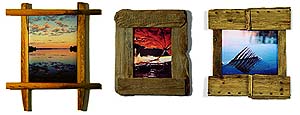
back to Timo-Olavi Jalkanen main Art Page
| By knowing the artist's
background
and motives, I conclude that compensation to stressful hitech life has
caused
him to create images that reminds to Japanese or Zen-Buddhist silent
philosophy
and spirituality. At the same time the works are very Nordic and
Finnish; like
moments from the Finnish national romantic epic, Kalevala. An ability to absolute focusing -- that obviously was needed in his previous career as a computer systems development engineer -- can also be seen in these works. They often use minimalistic elements. The subject alone is not important, more so the moment, emotion and the surrounding space. When there are no man-made elements in these images, and when they are not seeking “nature photographic” beauty, the viewer must work at very instinctive level when interpreting them. A real-life characterizing story, cause-consequence, what-why-questions, can not be found from these images. Insignificant subjects, independent in their own world, often alone, just take their sublime place in the works. Three dimensional wooden frames, collected from the spots of the images, emphasize window-like impression to the subjects. Ulrich Haas-Pursiainen, Curator for Nykyaika and Backlight (in the opening words of "When Time Stands Still" -exhibition at Valokuvakeskus Nykyaika, 2001) |
| In
these works the spirit-of-wilderness of North-Pirkkala rises up from
its sleep
of centuries. Tiina Nyrhinen, Art Critic (In the article of Aamulehti -newspaper, 2001) |
| This
is a philosophical exhibition. These images are from the places that
many
of us who are here now know, but now we see those places the way that
the
artist has seen them. The works are technically somewhere between
paintings
and photographs. When this collection was taken to the exhibition first
time,
there was some confusion what is actually the category for it. Dr. Lassi Saressalo, Director of Cultural Affairs in the City of Tampere (in the opening words of the "When Time Stands Still" -exhibition in Gallery Amanda, 2002) video clip |